Building Momentum in Resistance to Grand Canyon Uranium Mining & Transport
Photos by Dustin Wero | Instagram: darth_wero
In late 2016 Indigenous anti-nuke & sacred sites organizers decided something had to be done to confront the threat of radioactive uranium ore transport from the Grand Canyon to the White Mesa Mill. In December of 2016, volunteer-based Haul No! was formed to raise awareness, organize, and take action to protect sacred lands, water, and our health from this toxic threat. Haul No! got to work right away researching, creating outreach materials, exploring and advocating policy changes, and planning for direct action to stop the transport.
In March 2017, Energy Fuels Inc. (EFI), the owner of Canyon Mine and White Mesa Mill (the only commercially operating uranium processing plant in the US), announced that it could be ready to start mining uranium as early as June 2017. Haul No! kicked into gear and started organizing an awareness and action tour along the 300-mile planned haul route, coordinating with community hosts along the way.
BLUFF, UT – SHUT DOWN WHITE MESA MILL
Haul No! initiated the tour on June 13, 2017 in Bluff, Utah. Although we started the event a bit later than intended (our crew was converging from a range of different points in the Southwest), the Bluff Community Center had an energetic crowd of 35 people. Our tour presentation consisted of two parts: the first, on facts relating to Canyon Mine, the haul route, and White Mesa Mill; the second was Indigenous-rooted direct action training.
 The conversations centered around White Mesa Mill, which is located just 20 miles to the north of Bluff. White Mesa Mill was built in 1979 to process uranium ore from the Colorado Plateau. Since then, it has processed and disposed of some of the most toxic radioactive waste produced in the U.S. In 1987, it began processing “alternate feed material” (uranium-bearing toxic and radioactive waste) from across North America. Energy Fuels disposes of the mill’s radioactive and toxic waste tailings in “impoundments” that take up about 275 acres next to the mill. The mill is built on sacred Ute Mountain Ute lands. More than 200 rare and significant cultural sites are located on the mill site. When the mill and its tailings impoundments were constructed, several significant cultural sites were destroyed.
The conversations centered around White Mesa Mill, which is located just 20 miles to the north of Bluff. White Mesa Mill was built in 1979 to process uranium ore from the Colorado Plateau. Since then, it has processed and disposed of some of the most toxic radioactive waste produced in the U.S. In 1987, it began processing “alternate feed material” (uranium-bearing toxic and radioactive waste) from across North America. Energy Fuels disposes of the mill’s radioactive and toxic waste tailings in “impoundments” that take up about 275 acres next to the mill. The mill is built on sacred Ute Mountain Ute lands. More than 200 rare and significant cultural sites are located on the mill site. When the mill and its tailings impoundments were constructed, several significant cultural sites were destroyed.
The White Mesa Mill is currently undergoing renewal of its Byproduct Radioactive Material License (RML UT1900479) and the Groundwater Quality Discharge Permit for the White Mesa Uranium Mill. Utah Department of Environmental Quality held 2 public meetings in June, in Salt Lake City and Blanding.
A dozen community members from the nearby Ute Mountain Ute community of White Mesa, Utah joined the Haul No! tour stop and shared their experiences. Ephraim  Dutchie spoke about the spiritual quality of of the land and the environmental racism they experience not just from the Mill workers, but also from pro-Mill residents and law enforcement. “The don’t care about our community they only care about money. White Mesa is not the only community that will be affected by this. Keep water pure and land sacred.” Ephraim said.
Dutchie spoke about the spiritual quality of of the land and the environmental racism they experience not just from the Mill workers, but also from pro-Mill residents and law enforcement. “The don’t care about our community they only care about money. White Mesa is not the only community that will be affected by this. Keep water pure and land sacred.” Ephraim said.
Bluff and White Mesa community members also expressed great concern that their drinking water will be contaminated by further milling operations. The Navajo Sandstone aquifer lies right beneath the mill site. Other comments included concerns about accidents, leaks, and the liners of the tailings impoundments (such as quality, maintenance, and replacement).
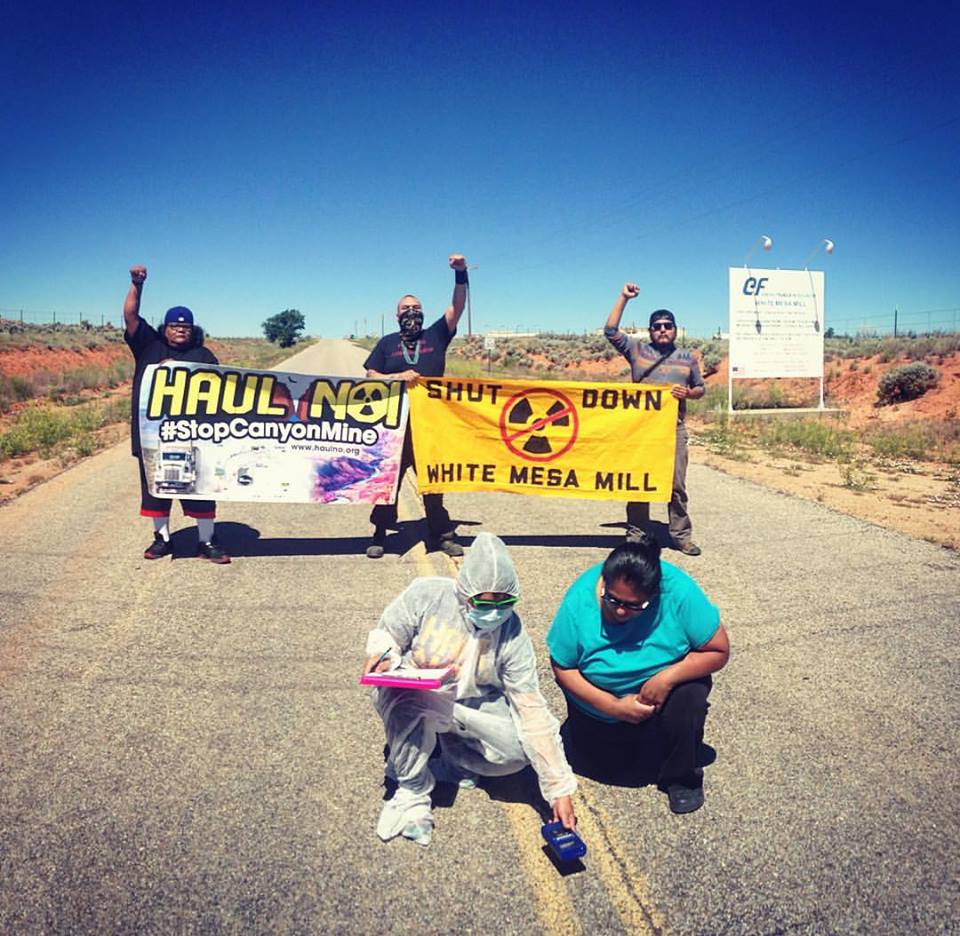
The following day, the Haul No! crew, comprising of Leona Morgan, Sarana Riggs, Klee Benally, Dustin Wero, and Bobby Mason, met up with Ute Mountain Ute organizers at the entrance to White Mesa Mill. Haul No! volunteer Leona Morgan, who also works with Diné No Nukes and Radiation Monitoring Project, donned her hazmat suit & mask to monitor radioactive pollution at the entrance of the mill. When mistaken for being simply a photo-op, Leona said, “I’m not just messing around guys…I’m really working here.”
In the past two years alone, two radioactive spills have occurred en route to the mill. Both involved haul trucks from the Cameco Resources uranium mine in Wyoming and spill in march that spread radioactive barium sulfate sludge along U.S. Highway 191.
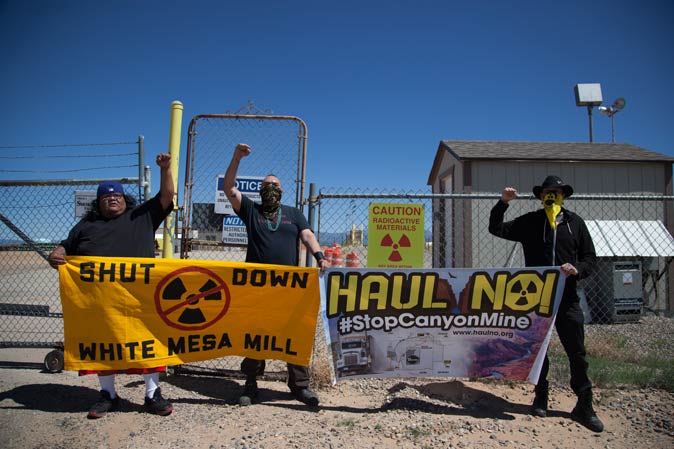
After Dustin took some pictures with Haul No! crew & Ute Mountain Ute defenders, part of the crew went directly to the Mill site to bring the message that we want them to shut down. Yolanda Badback confronted EFI workers as law enforcement agents arrived. Apparently 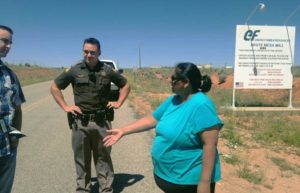 there was a call made regarding trespassing and vandalism. Yolanda stated, “This was our land and now it’s poisoned, Energy Fuels has no right to be here.” Our crew is adept at dealing with law enforcement encounters so there were no issues aside from a warning.
there was a call made regarding trespassing and vandalism. Yolanda stated, “This was our land and now it’s poisoned, Energy Fuels has no right to be here.” Our crew is adept at dealing with law enforcement encounters so there were no issues aside from a warning.
We ate and slept well that night thanks to our gracious hosts in Bluff. We look forward to returning.
TAKE ACTION: Send your own comments regarding renewals of White Mesa Mill’s permits. Public comment period ends on July 31, 2017. Click here for more info & a form letter, you can also email your comments directly to: dwmrcpublic@utah.gov
OLJATO, UT/MONUMENT VALLEY/KAYENTA, AZ – A LEGACY OF ABANDONED URANIUM MINES
Our next stop on the tour took us to Oljato, Utah, which is located within the iconic Monument Valley. Our crew split forces for event set-up and outreach at Kayenta Flea Market. The Oljato event turned into a planning session with a radio interview thrown in. Although the Chapter President assisted us with scheduling the event, no one showed; but that didn’t
Our crew split forces for event set-up and outreach at Kayenta Flea Market. The Oljato event turned into a planning session with a radio interview thrown in. Although the Chapter President assisted us with scheduling the event, no one showed; but that didn’t 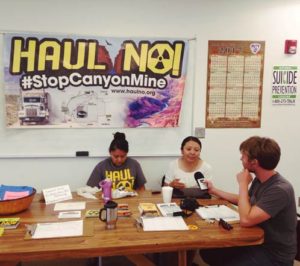 dampen our spirits. We knew the community had already passed a strong resolution opposing transport and has long been plagued by abandoned uranium mines. Oljato Chapter was actually the first to pass such a resolution in December 2016. In fact, the feature documentary Return of Navajo Boy, which is partly responsible for triggering the Navajo Nation 5-year clean up program, focused on a family living in Monument Valley.
dampen our spirits. We knew the community had already passed a strong resolution opposing transport and has long been plagued by abandoned uranium mines. Oljato Chapter was actually the first to pass such a resolution in December 2016. In fact, the feature documentary Return of Navajo Boy, which is partly responsible for triggering the Navajo Nation 5-year clean up program, focused on a family living in Monument Valley.
In Oljato/Monument Valley, we did more one-on-one outreach and education regarding the issue, to the Navajo Utah Commission, market vendors, and the Chapter Vice President.
Throughout the Navajo Nation, Diné families have been subject to decades of radioactive contamination ranging from unsafe working conditions at mines and mills, to living in houses built from materials taken from uranium mines. Well water is documented by the US Environmental Protection Agency (EPA) as undrinkable in at least 22 communities such as Black Falls on the Dine’ Nation. According to EPA, there are more than 523 abandoned uranium mines located though the Navajo Nation. This prompted the Navajo Nation to take action and ban uranium mining and milling in 2005. The Nation banned transport of radioactive materials in 2012. Though this matter is one of conflict due to lack of jurisdiction over state-controlled highways such as the EFI’s Canyon Mine haul route. This point is a focus regarding policy work for Haul No!.
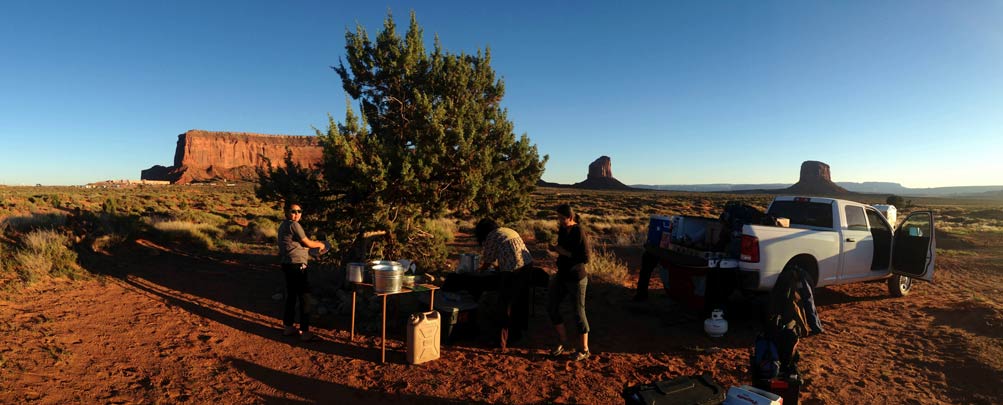 Due to the gracious hosting of Leroy Teeasyatoh from Sacred Monument Tours, we cooked and camped under the stars at an isolated overlook of Monument Valley. With abandoned uranium mines and the massive stone icons that draw thousands and thousands of tourists every year surrounding us, we couldn’t have asked for a better view to prepare us more for the work ahead. The stories we heard throughout the day, of trauma and beauty, echoed their contrast into the night and throughout our dreams.
Due to the gracious hosting of Leroy Teeasyatoh from Sacred Monument Tours, we cooked and camped under the stars at an isolated overlook of Monument Valley. With abandoned uranium mines and the massive stone icons that draw thousands and thousands of tourists every year surrounding us, we couldn’t have asked for a better view to prepare us more for the work ahead. The stories we heard throughout the day, of trauma and beauty, echoed their contrast into the night and throughout our dreams.
Sunrise at Monument Valley is unparalleled. We broke camp and ventured to a visitors center, where we cleaned up, drank coffee, passed out literature, and worked out logistics. We held our Haul No! banner for the requisite Monument Valley photo and got the attention of a Gallup Independent journalist doing a story on the Bears Ears National Monument.
After that, our crew had to split to cover more ground. Two folks headed to Blanding, Utah to testify at the White Mesa Mill re-licensing hearing that was being held that night; while the rest of the crew headed to Kayenta where we would be holding down that evening’s tour stop. Our ranks were reinforced by Leilani Clark, a fierce Indigenous organizer from Tucson by way of Las Vegas.
The Kayenta event was held at the Township, which is less than a 1/4 mile from the transport route. We  had an intimate yet passionate group attending our presentation. We had a little more time for the direct action training which was very energetic. A lot of folks stated that they’ve already seen trucks that look like they’re hauling uranium barreling through their town. We clarified that at this point we know that uranium and arsenic-laced water from Canyon Mine was being transported in unmarked vehicles, and that this may be un-permitted. It was very clear that those in attendance do not want any more radioactive materials transported through their community.
had an intimate yet passionate group attending our presentation. We had a little more time for the direct action training which was very energetic. A lot of folks stated that they’ve already seen trucks that look like they’re hauling uranium barreling through their town. We clarified that at this point we know that uranium and arsenic-laced water from Canyon Mine was being transported in unmarked vehicles, and that this may be un-permitted. It was very clear that those in attendance do not want any more radioactive materials transported through their community.
We heard first-hand accounts of the nuclear industry’s toxic legacy and in our conversations realized that everyone on our tour had family directly impacted by uranium mining and milling.
We re-grouped with the crew that went to the White Mesa Mill hearing at Amigo Cafe (shout out to Billy!), and heard that the Mill workers were out in force. Sarana had testified in support of Ute Mountain Ute and spoke to the harmful legacy that the Navajo Nation still faces with the 5 uranium mill sites still plaguing our lands.
We decided to head directly to Tuba City that evening, so we could set up an outreach table at the Flea Market first thing in the morning.
TUBA CITY, AZ – RARE METALS’ DEADLY LEGACY
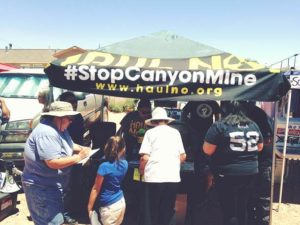 After a solid night’s sleep, part of our crew set up a table at the Tuba City Flea Market. It was a beautiful and busy day in Tuba. We were able to get nearly a hundred signatures and pass out a plethora of info. At one point our booth was so packed we had a line.
After a solid night’s sleep, part of our crew set up a table at the Tuba City Flea Market. It was a beautiful and busy day in Tuba. We were able to get nearly a hundred signatures and pass out a plethora of info. At one point our booth was so packed we had a line.
More than anything we heard constant accounts of cancer and passing of relatives due to work at Rare Metals Tuba City uranium Mill.
 If you’ve ever passed through Rare Metals, just about 5 miles Northeast of Tuba City, you may have seen the outlines of foundations from houses that once stood adjacent to the toxic site. From June 1956 to November 1966, the Tuba City Rare Metals Mill processed 796,489 tons of uranium ore. Department of Energy started cleaning up the mill site in 1988, though groundwater contamination and technical problems continue to plague the Superfund site.
If you’ve ever passed through Rare Metals, just about 5 miles Northeast of Tuba City, you may have seen the outlines of foundations from houses that once stood adjacent to the toxic site. From June 1956 to November 1966, the Tuba City Rare Metals Mill processed 796,489 tons of uranium ore. Department of Energy started cleaning up the mill site in 1988, though groundwater contamination and technical problems continue to plague the Superfund site.
To this date, a layer of soil and rock is the only covering over 2.3 million tons of hazardous waste. A rock  dam surrounds the radioactive waste to control runoff water that flows into nearby Moenkopi Wash.
dam surrounds the radioactive waste to control runoff water that flows into nearby Moenkopi Wash.
 That evening we gathering with our crew and host Vanessa Brown to present at Grey Hills Auditorium. We had more than 40 participants. When Leona asked how many people in attendance had a relative or were themselves directly impacted by uranium mining or milling, everyone raised their hands.
That evening we gathering with our crew and host Vanessa Brown to present at Grey Hills Auditorium. We had more than 40 participants. When Leona asked how many people in attendance had a relative or were themselves directly impacted by uranium mining or milling, everyone raised their hands.
All those at the presentation expressed strong opposition to further 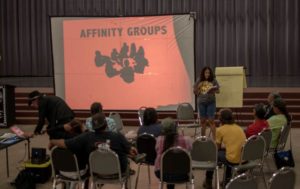 transport of radioactive materials through their lands. We had two breakout groups: one working on policy issues and education, the other direct action.
transport of radioactive materials through their lands. We had two breakout groups: one working on policy issues and education, the other direct action.
As there were long-time anti-nuke organizers in attendance, the discussion was insightfully powerful.
 It was time for our team spread out again. Leona represented at the Asdzaa’ Warrior Fest at K’e’ Infoshop in Window Rock, while the rest of us organized for the rest of the tour and the Havasupai Red Butte Gathering.
It was time for our team spread out again. Leona represented at the Asdzaa’ Warrior Fest at K’e’ Infoshop in Window Rock, while the rest of us organized for the rest of the tour and the Havasupai Red Butte Gathering.
FLAGSTAFF, AZ – A CRITICAL POINT OF INTERVENTION
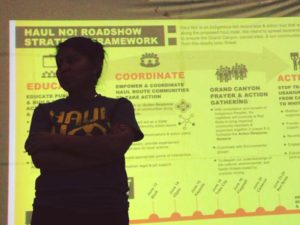 Our tour continued on Monday, June 19 in Flagstaff at the Coconino Center for the Arts. 65 people attended the presentation. We also had long-time anti-nuke advocates such as Alicyn Gitlin (Sierra Club), Ryan Beam (Center for Biological Diversity), Berta and Jones Benally, Uncle Don Fanning, and Dr. Tommy Rock, who has been a great force in researching and educating Diné communities on impacts of uranium mining. Dr. Rock has also been responsible for getting resolutions opposing uranium transport passed at Navajo Chapters.
Our tour continued on Monday, June 19 in Flagstaff at the Coconino Center for the Arts. 65 people attended the presentation. We also had long-time anti-nuke advocates such as Alicyn Gitlin (Sierra Club), Ryan Beam (Center for Biological Diversity), Berta and Jones Benally, Uncle Don Fanning, and Dr. Tommy Rock, who has been a great force in researching and educating Diné communities on impacts of uranium mining. Dr. Rock has also been responsible for getting resolutions opposing uranium transport passed at Navajo Chapters.
At several of the other stops, many communities have asked what Flagstaff was doing to stop transport, as they see the community as sort of “gatekeeper” in the transport route. This is where some of the Haul No! policy strategy has been focused.
The next evening our crew with more Flagstaff Community members delivered a petition to Flagstaff City Council calling for a resolution and ordinance to oppose uranium transport. Flagstaff has jurisdiction over a small part of the transport route and organizers see this as a possible stopping-point to ensure other communities down the line are safeguarded as well.
CAMERON, AZ – A LEGACY OF ABANDONED URANIUM MINES (CONTINUED)
 On Tuesday, June 20 we finally made it to Cameron after some complicated logistics (the initial date didn’t work for the community and then the alternate location had water issues so had to cancel). The crowd was mainly comprised
On Tuesday, June 20 we finally made it to Cameron after some complicated logistics (the initial date didn’t work for the community and then the alternate location had water issues so had to cancel). The crowd was mainly comprised 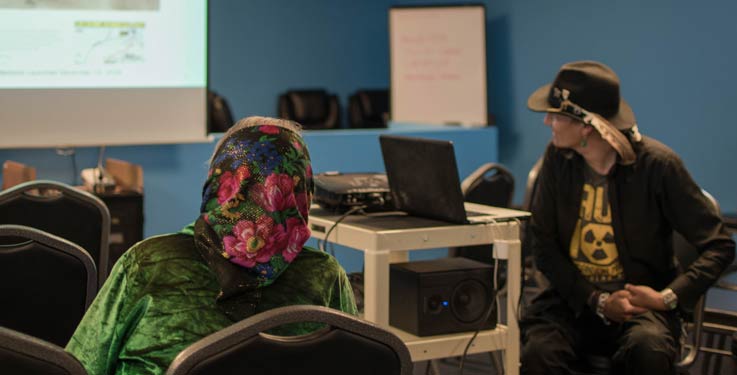 of elders. One participant expressed in Navajo how grateful she was to see young people working on this issue. Every participant at the Cameron tour stop had been impacted directly by uranium mining and expressed great concern if any transport of high-level radioactive ore was to come through their lands. The small community, which is a gateway to the Grand Canyon’s East entrance, has faced uranium contamination for decades.
of elders. One participant expressed in Navajo how grateful she was to see young people working on this issue. Every participant at the Cameron tour stop had been impacted directly by uranium mining and expressed great concern if any transport of high-level radioactive ore was to come through their lands. The small community, which is a gateway to the Grand Canyon’s East entrance, has faced uranium contamination for decades.
There are more than 100 abandoned uranium mines (AUMs) in the Western region of the Navajo Nation with a majority of them located in the Cameron area. These AUMs are located along the Little Colorado River and Highway 89, and are in the Cameron, 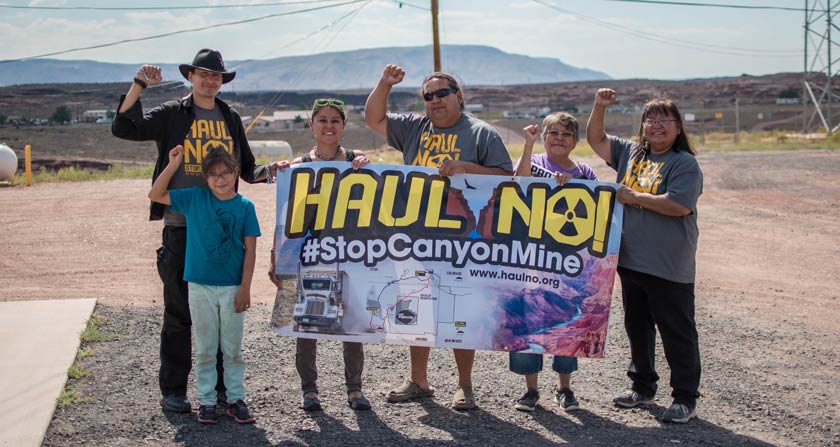 Coalmine Canyon, Bodaway/Gap, and Leupp Chapters. In 2007, a Five-Year Plan was established at the direct of US Congress to address uranium contamination on the Navajo Nation. Under the plan there are 43 priority mine claims and so far only two have been cleaned up. While several AUMs around Cameron have been identified for clean up, some sites remain unmarked and unfenced with little assurance from the EPA as to when actual clean up will begin.
Coalmine Canyon, Bodaway/Gap, and Leupp Chapters. In 2007, a Five-Year Plan was established at the direct of US Congress to address uranium contamination on the Navajo Nation. Under the plan there are 43 priority mine claims and so far only two have been cleaned up. While several AUMs around Cameron have been identified for clean up, some sites remain unmarked and unfenced with little assurance from the EPA as to when actual clean up will begin.
Cameron officials have already expressed that they are willing to block uranium transport if it comes towards their community.
A big thank you again to everyone who contributed, supported, hosted, donated, organized, and attended along the way!
PART 2: RED BUTTE GATHERING
Coming soon!
Please sign our pledge or resistance (even if you have already as we had some website issues)!
www.haulno.com/pledge/
Please donate to support our volunteer work!
www.haulno.com/campaigns/support-haul-no-crowdfunding-campaign/
Outcomes and Impacts:
Overall Haul No! accomplished the goals we set out for along the tour:
- to raise awareness and educate communities along the Canyon Mine haul route about the threat.
- build a base of support for action and policy work.
- organize an action response network.
Additional outcomes:
- City of Flagstaff placed resolution/ordinance on agenda for July 5, 2017
- outreach at Flea Markets and other events extended our reach to more than 700 people
- social media presence increased and media coverage,
We also had a range of requests at each event that included:
- further community outreach including signs along the haul route
2. additional presentations in other venues or other communities
Next Steps:
You know that Haul No! has been planning ahead for months right. 😉
Some of our next steps include:
1. Further regionally focused awareness and education.
2. Support Ute Mountain Ute in getting the word out about White Mesa relicensing.
3. building and deploying signs along haul route.
4. Havasupai & Hopi follow-up presentations
5. Continued work on Chapter resolutions
6. Continued work on Navajo Nation Council action
7. get more pledge’s of resistance
8. Additional direct action trainings in Flagstaff
Haul No! Tour Volunteer Crew:
Leona Morgan
Sarana Riggs
Klee Benally
Dustin Dwero
Bobby Mason
Leilani Clark
Roland Begay
Logan Tracy
Tour miles: 300
Tour stops: 7
Total event participants: 160
###

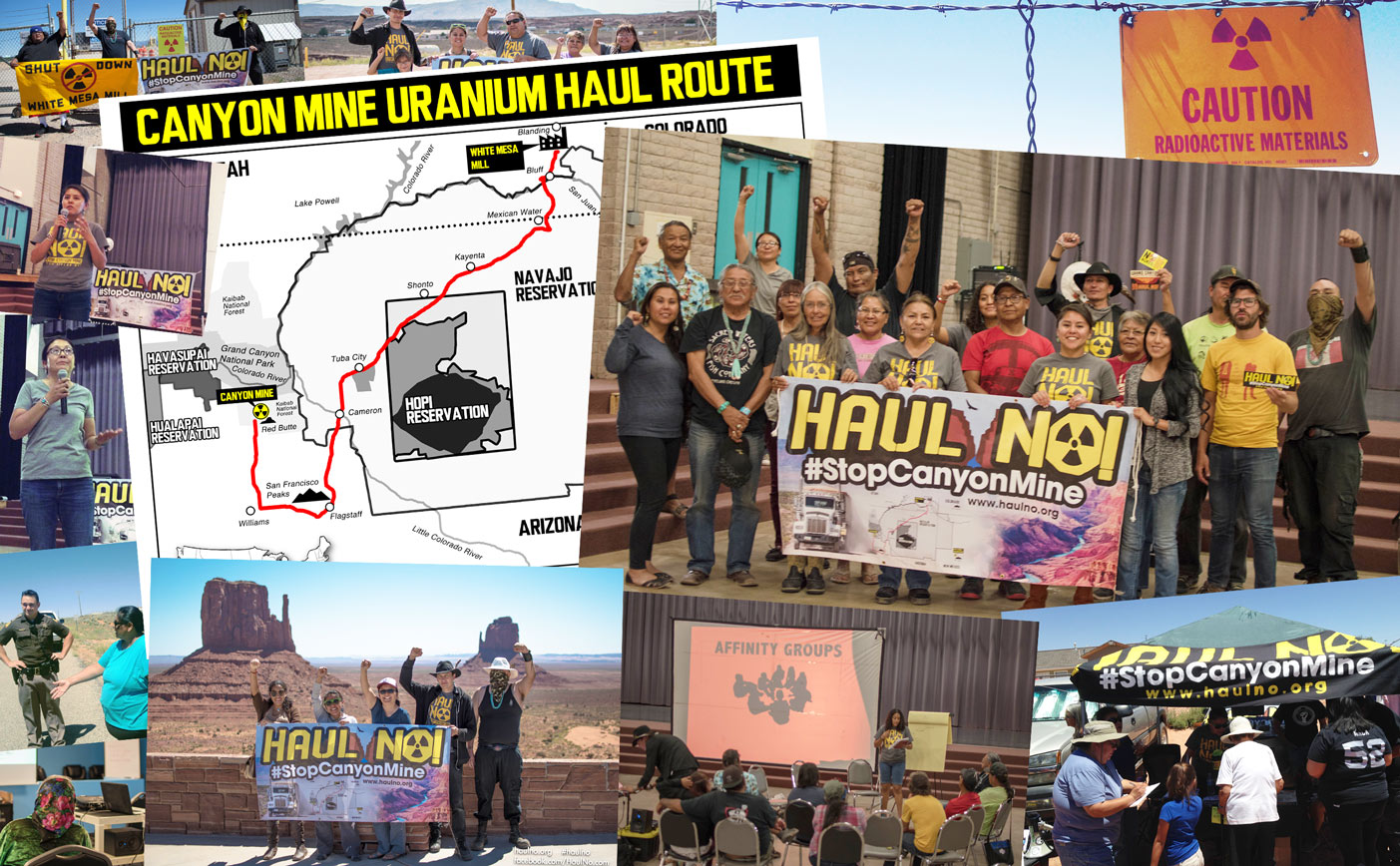
French translation:
http://www.chrisp.lautre.net/wpblog/?p=4120
Thanks so much to the White Mesa Utes and the Havasupai for leading the campaign against uranium mining and milling. It is an honor to stand with you.